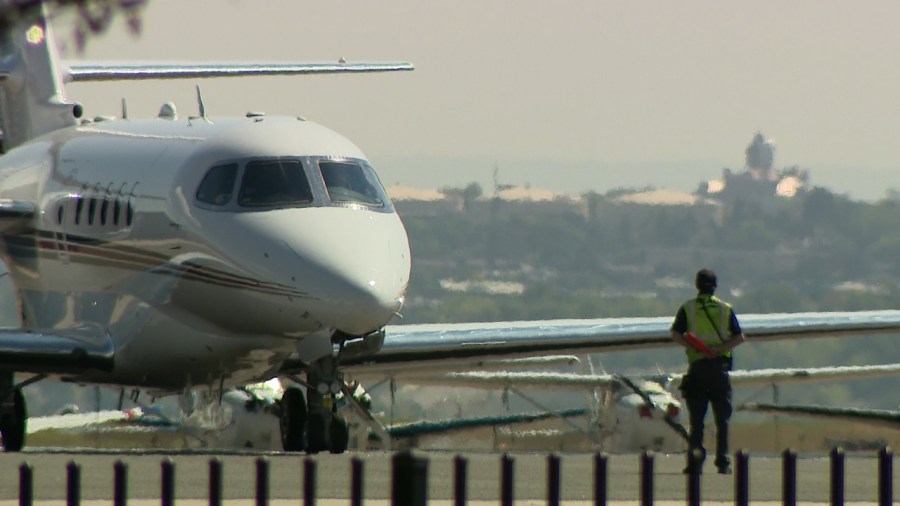[ad_1]

SUPERIOR, Colo. (KDVR) — FOX31 obtained an internal memo from the Federal Aviation Administration that said Rocky Mountain Metropolitan Airport currently leads the national airspace system in airborne safety incidents.
The FAA memo, dated June 10, states, “Rocky Mountain Metropolitan Airport currently leads the National Airspace System (NAS) in the number of Potentially Significant Events (PSEs), which include both runway incursions and airborne safety incidents.”
FOX31 spoke to the town of Superior’s Mayor Mark Lacis about the designation.
“It’s really troubling,” Lacis said. “We’ve been asking for help for years from the FAA, from Rocky Mountain Metropolitan Airport, from Jefferson County, all of whom have either refused to talk to us, declined to speak to us, pointed the finger at somebody else for the responsibility. Meanwhile, our residents are unable to sleep at night because it’s so noisy. We’re seeing crashes routinely in the area, so it’s only a matter of time before one of these flight school training planes lands in a house or school.”
RMMA’s Director, Erick Dahl, sat down with FOX31 to address the memo.
“This is an internal FAA memo to itself, but we don’t control flight paths,” Dahl said. “We don’t control altitudes. We don’t control how planes approach in and out of the airport. That is purely the FAA’s prerogative.”
Dahl said safety is RMMA’s top priority. FOX31 asked how the airport controls safety.
“So part of our job as managing the airport infrastructure is making sure the airfield gets inspected, making sure that all of the airfield itself is properly maintained,” Dahl said. “And that’s where the airport’s focus is on the on the ground type actions. FAA is in the airspace.”
Six days after the internal memo was dated, a spokesperson told FOX31 the FAA adjusted operating procedures at Rocky Mountain Metro Airport to enhance air traffic safety and efficiency.
“Effective June 16, 2025, the FAA, in coordination with local BJC airport flight schools and other airport users, implemented structured traffic flows to and from the runways to minimize risk and increase safety,” an FAA spokesperson said.
“We were not included about the study,” Dahl said. “They didn’t ask us about what our thoughts were on changing the flight paths. And, you know, it kind of took us by surprise, too. And we took the comments that we received and pass that on to the FAA as well, saying, hey, these flight plans are having potentially impacts here, some community noise concerns that they’re being expressed.”
“On the one hand, I’m grateful that the FAA is taking matters of safety seriously,” Lacis said. “But at the end of the day, the problem is the volume of the traffic. We’ve co-existed with this airport for decades. It only became a problem over the past four or five years. The homes are already there. But what came with additional flight schools and all of these training operations?”
An RMMA spokesperson told FOX31 there are five fixed-wing flight schools at RMMA that all vary in size.
On the airport’s FAQ page, this is the response to the question “Why can’t RMMA ban flight schools?”
A number of flight schools are based at RMMA, either through leases directly with the airport or via sublease from another airport tenant. RMMA is a federally funded airport bound by FAA Airport Sponsor Assurances. The sponsor assurances require that RMMA “make the airport available as an airport for public use on reasonable terms and without unjust discrimination to all types, kinds and classes of aeronautical activities, including commercial aeronautical activities offering services to the public at the airport.” (Airport Sponsor Assurance 22.a.). As RMMA continues to develop or redevelop, Jefferson County will consider aeronautical activities of all types while seeking to balance out the current aeronautical mix.
“Safety is our top priority here at the airport,” Dahl said. “For unleaded fuel, we’re certainly doing our part there. We’re transitioning to unleaded fuel or working through that process here. Hopefully, by the end of the year, we’ll have our unleaded fuel tank in operation.”
As Lacis mentioned, noise continues to be a big concern for surrounding residents.
“For noise, we’re currently doing our Part 150 study that the community asked us to do,” Dahl said. “We’re certainly working with our focus groups and our committee members on what that airport might look like from noise. But that part 150 study is ongoing.”
Community members can visit the Part 150 Study website to review the information presented so far and submit public comments. According to RMMA, the public comments are shared with the FAA as part of the study’s record.
The FAA also shared the following statement with FOX31 when asked about community concerns surrounding noise and lead pollution:
“The FAA is committed to meaningful dialogue with communities. The agency continuously works to help reduce the number of people exposed to aviation noise in communities around airports. Addressing this concern requires collaboration among the FAA, air carriers, airports, aircraft manufacturers, research universities, local communities and elected officials.”
If a community is concerned about aircraft noise, the best course of action is to contact their local aviation community roundtable or airport operator. The FAA can then work with airport operators to determine if the aircraft noise can be mitigated through changes in air traffic procedures. The public can submit noise complaints here.
[ad_2]

Anthony Sutton is a business strategist and writer with a passion for management, leadership, and entrepreneurship. With years of experience in the corporate world, he shares insights on business growth, strategy, and innovation through management-opleiding.org.




